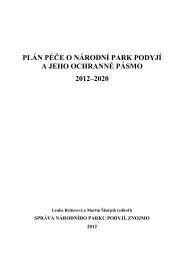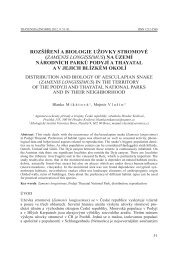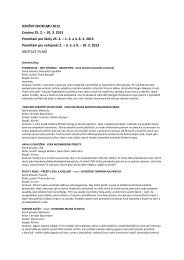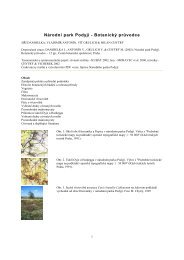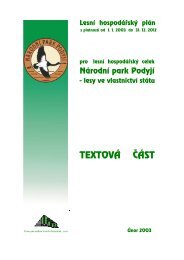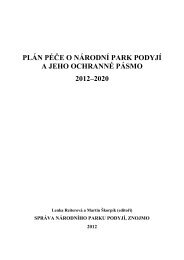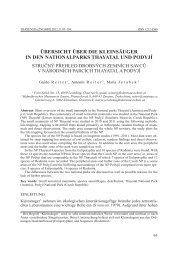Thayensia supplementum I. - Národnà park PodyjÃ
Thayensia supplementum I. - Národnà park PodyjÃ
Thayensia supplementum I. - Národnà park PodyjÃ
You also want an ePaper? Increase the reach of your titles
YUMPU automatically turns print PDFs into web optimized ePapers that Google loves.
in the closer environs of Znojmo near Trausnitzer Mill and in that of Býčí skála. Even the more eastern<br />
parts of the border zone, the environs of Ječmeniště, Jaroslavice, Hevlín, and Hrabětice, were<br />
probably known to him only partially; especially from the latter two localities he adopted many data<br />
from earlier investigations.<br />
A diligent and ardent amateur botanist, Drlík investigated a number of places omitted by his prede<br />
ces sors and often even unknown to the Brno botanists working at the same time (Figs. 3 and 4).<br />
In this way Drlík recorded the interesting flora of the later destroyed salt marshes near Hodonice,<br />
Stošíkovice na Louce, and Načeratice. He presents a number of data from the forests near Šumná<br />
and Bojanovice, localities rather overlooked by the botanists of that time, as well as from the western<br />
part of the Znojmo region (Zálesí and the forests in the environs of the Vranov Reservoir). His data<br />
from the brook valleys near Znojmo (Gránice, Smoha) are numerous and valuable as well. With his<br />
notes on the well-known localities around Konice, Popice, Havraníky, Hnanice, Hradiště, Načeratice,<br />
along the Dyje River and from Purkrábka, Drlík fills the time lag between the time of Oborny in the<br />
late 19 th century, that of Wolfgang Himmelbaur in 1915–1918, and the late 20 th century when a new<br />
period of intensive floristic investigations began (GRULICH 1997).<br />
Due to his activity shortly before the basic changes of land use took place, and due to his being<br />
focused on habitats outstanding and interesting in floristic respect (salt marshes, waterlogged meadows,<br />
extensively used fields and pastures), Drlík recorded in his „Květena“ a large number of species which<br />
vanished from the Znojmo region and its wider environs shortly thereafter. In the cases of several<br />
species he even presents the last or even the very last dated information on their occurrence in the<br />
Czech Republic (Ceratocephala testiculata, Camelina sativa, Lolium temulentum, Lolium remotum,<br />
Scandix pecten-veneris) or in Moravia (Myosotis discolor, Ornithogalum umbellatum, Turgenia latifolia).<br />
Many other species, documented in the Znojmo region by Drlík, have not been confirmed any<br />
more (e.g. Agrostemma githago, Aster tripolium, Astragalus exscapus, Blysmus compressus, Cardaminopsis<br />
halleri, Cephalanthera longifolia, Conringia ori en ta lis, Crepis foetida subsp. rhoeadifolia,<br />
Gentiana pneumonanthe, Hibiscus trionum, Juncus gerardii, Moneses uniflora, Pedicularis palustris,<br />
Pedicularis sylvatica, Plantago arenaria, Plantago maritima, Pu li ca ria vulgaris, Pyrola chlorantha,<br />
Sideritis montana, Taraxacum bessarabicum, Torilis arvensis, Triglochin palustre, Vaccaria hispanica<br />
subsp. grandiflora, Viola suavis). Some of the significant herbarium items are shown in Figs. 5–16.<br />
A more detailed analysis to evaluate the development of the particular habitats and their flora, based on<br />
a comparison of Drlík’s „Květena Znojemska“ with data provided by his predecessors and followers,<br />
however, is beyond the scope of this short summary, and it will be the topic of a more detailed study.<br />
Directly in the chapter on the „Systematic synopsis of species“, the present co-authors only sup plemen<br />
ted references to the revised herbarium items pertaining to Drlík’s manuscript. From the present<br />
point of view they comment upon some rare, taxonomically complicated, or otherwise interesting plant<br />
species or groups. Also, they supplemented the index of specific taxons used both at the time of origin<br />
of the work (DOSTÁL et al. 1948–1950) and in the present Czech literature (KUBÁT et al. 2002).<br />
Being a private investigator, Drlík evidently had no means by which to consult his identifications<br />
with specialists. This is quite evident from the level of some of his determinations. Apparently, he was<br />
more familiar with some of the groups so that there are few misidentifications in them, whereas in other<br />
groups he committed rudimentary errors (e.g. in determining certain poaceous plants). Nowadays,<br />
Drlík cannot be blamed for such errors. On the contrary, his endeavour at consistently accumulating<br />
herbarium documents is unusually valuable, and it is the confrontation of his collection with the text<br />
of his manuscript that permits the present critical attitude to his legacy.<br />
LITERATURA<br />
BUREŠ P. (1996): Cardamine dentata Schult. in Moravia. – Scr. Fac. Rer. Natur. Univ. Masaryk. Brun.<br />
– Biol., Brno, 24 (1994): 3–9.<br />
ČECH L., ŠUMPICH J., ZABLOUDIL V. et al. (2002): Jihlavsko. – In: MACKOVČIN P., SEDLÁČEK M. [eds.]:<br />
Chrá ně ná území ČR 7. AOPK ČR a EkoCentrum Brno, Praha, 1–528.<br />
ČEŘOVSKÝ J., FERÁKOVÁ V., HOLUB J., MAGLOCKÝ Š., PROCHÁZKA F. (1999): Červená kniha ohrožených<br />
a vzácných druhů rostlin a živočichů ČR a SR. Vol. 5. Vyšší rostliny. – Príroda, Bratislava.<br />
279



